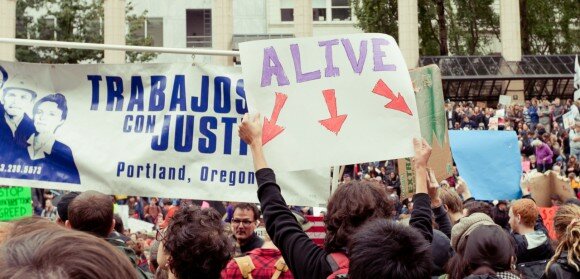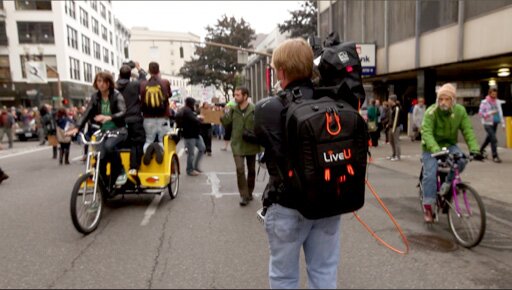
With the growing momentum behind the Occupy Wall Street movement, I knew there would be a lot of press at the Occupy Portland march. Josh and I went over and watched as they kicked off their march to speak to the media who associated themselves with the movement, see what tools they were using, and if there were any tricks I might be able to learn from them as well.
A lot of dSLRs were there, it’s clear that shooting dSLR is the approach that most excites people. There were a number of high quality audio recorders too. Speaking to people it’s clear that these high bench marks are simply what they expect of themselves. There were a number of other cameras, standard def mini Dv, even a High 8 camera that I recognized from my high school days. But, the majority of the movement was using dSLR cameras.
The number of cell phone pictures taken was pretty startling too. Almost anyone the march passed would take a picture of it. To post on Facebook, twitter, or to show their friends later at the bar is for them to say. But I lost track of counting cell phones photos being taken after seeing 40 and we had only gone two blocks.
One particular interesting setup was the few people who combined the sophistication of high quality cameras with cellular modem technology. Here is one person who was streaming video live via a LiveU backpack.

Here is another, a kit setup by Dan Kaufman (of crank my chain!), using the same method of cellular modem transmission, but with a homebrew approach.
This brought me back to the use of TXTmob at the 2004 RNC. It was not common yet to use text messages for widespread but specific communication, but protestors were utilizing it to keep each other informed. Now tools like twitter are indispensable to journalists and activists for monitoring breaking news as well as communicating with each other.
I see these early adopters as an example of what we have to expect. Right now cell phone technology is the easiest way to do this. You can affordably communicate with the world instantly. But, the more technologies like EyeFi cards and cell phone modems become cheaper and more affordable, the easier it will be to be step around the quality limitations of our every shrinking cell phones and utilize more powerful tools for story telling.
If you’re still interested, you can check out a few unedited interviews on our YouTube Page too: